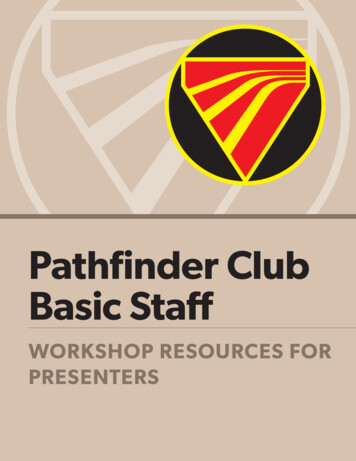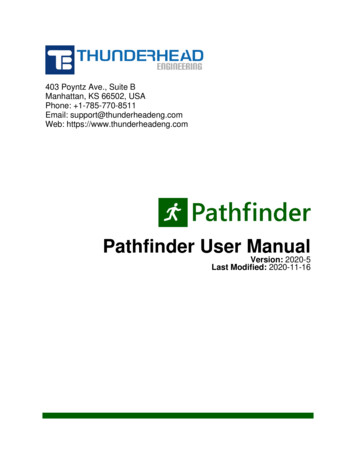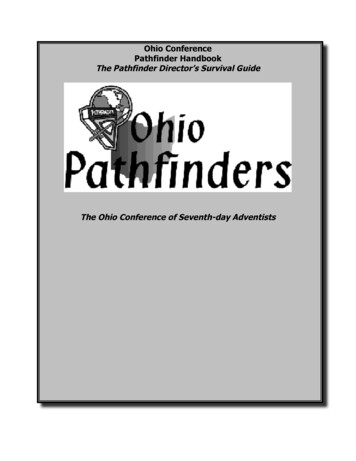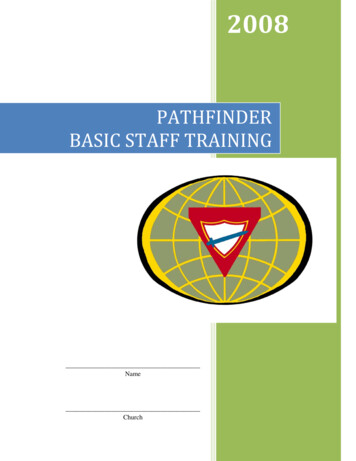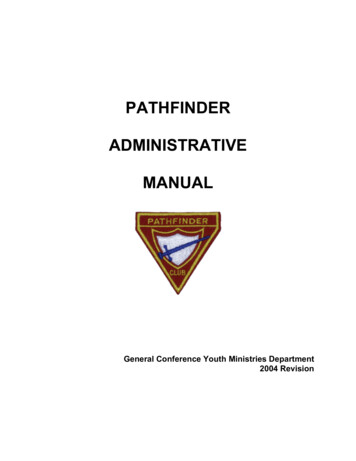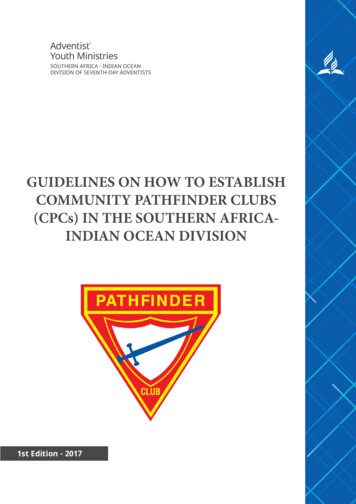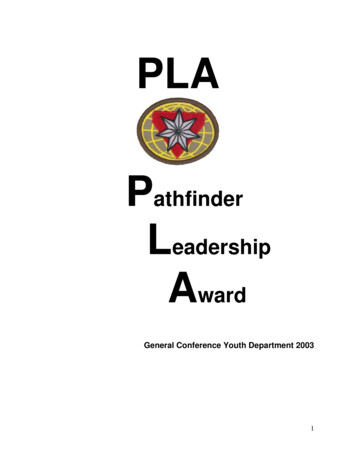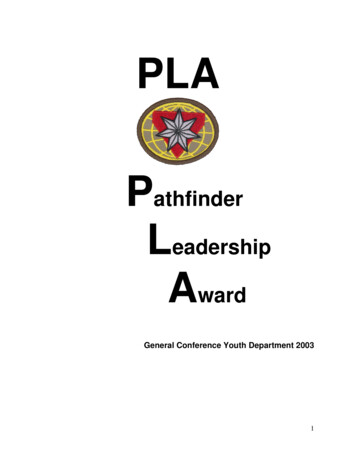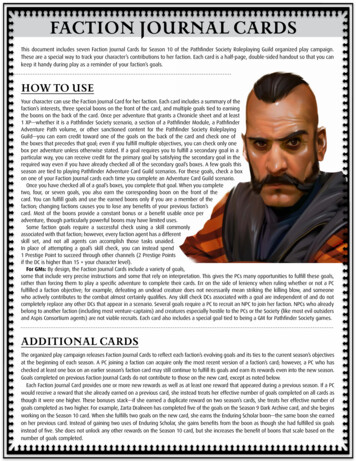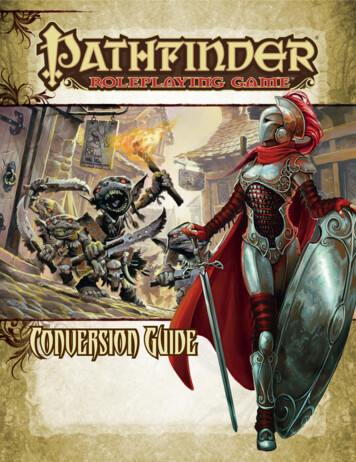
Transcription
PATHFINDER HANDBOOK UPDATEFellow scouts:We are in the final stages of editing the new Pathfinder Handbook. Although the book is not yetcomplete, the Pathfinder Handbook Committee has decided to release three vital chapters ofthe new handbook immediately so current scouts may enjoy the new Pathfinder program assoon as possible.The attached chapters 26, 27, and 28 of the OSG PATHFINDER HANDBOOK 4TH EDITION(PREVIEW JUNE 2022), will replace pages 87-120 in the BPSA-US Pathfinder Handbook (3rdEdition, Revision 2.2, August 2014). Keep your old handbook, as you will need the text forreference and guidance for your progress in Tenderfoot and Second Class.Please note: Once the new, revised handbook is complete, these new chapters will be mergedwith the complete handbook and both the chapter numbers and page numbers may beupdated.The new chapters here represent and entirely revised program for special proficiency badgesand advanced awards. There are 101 new special proficiency badges in both familiar subjects aswell as brand new skills. There are now special interest pins to show your area(s) of focus. Inaddition, there are slightly updated requirements for First Class, as well as three other, parallel,Pillar Awards that you can earn. Finally, OSG has created a new pinnacle award called thePolaris Award.See your Scoutmaster to discuss how any current progress you have made toward proficiencybadges or awards can be transferred to the new badges.We want your feedback. Please send email to pathfinder@osg-us.org if you have any concerns,questions, or recommendations for the Pathfinder program or handbook.Yours in Traditional Scouting,The Pathfinder Handbook CommitteeOutdoor Service GuidesJune 2022
26The Four PillarsThe heart of the Pathfinder program is the four pillar awards. Theyrepresent achievement in one of our core areas, and they prepare you toembark on new adventures in our communities or in the backwoods.The four pillar awards are: First Class, Torchbearer, Trailblazer, and Voyager.You can earn each of these awards separately, and a scout who achieves any threeof them is eligible to receive the highest award in Pathfinders, the Polaris Award. A First Class scout is one who develops some of the traditional scout skillslaid out in the original program a century ago. A Torchbearer is focused on civics, leadership, and volunteering. A Trailblazer is focused on creativity, on exploring our shared humanjourney and sharing our stories through many different mediums. A Voyager specializes in a different kind of journey: that of personal selfdiscovery and self-improvement.Which type of scout would you like to be? The good news is: You don’t have tochoose. You can be more than one. You can even be all four.Each pillar is identified by a color: First Class is green, Torchbearer is red,Trailblazer is tan, and Voyager is blue. The four pillars insignia are stripes of thepillar’s signature color, stitched with golden laurel leaves. The stripes are worn on
152OSG PATHFINDER HANDBOOK 4TH EDITION (PREVIEW JUNE 2022)How to braid a simple shoulder cordMeasure a length of paracord that is three times the length around your shoulder, and add anextra 12 inches. Lay your paracord out, tripling up with 3 inches to spare on each side.At one end, begin your braid using the steps below.12ABCA3CB4CA B5CBA6BCAB7ACABCTighten the braid as you go along. Repeat steps 2-7 as many times as necessary to braid theentire length, tucking the last loose end into the loop to finish.Loop your braid into a circle and tie ends together using a sheet bend. Don't forget to melt theends to prevent fraying.the left sleeve of your uniform, beneath your Second Class badge.In the chapter describing special proficiency badges, you will find that each badgeincludes a colored band indicating which pillar it belongs to.When you have earned a pillar, you can also wear a shoulder cord looped aroundyour right arm, along the seam of your shirt sleeve. The shoulder cord is madefrom a length of paracord, braided and tied with a sheet bend. If your uniformshirt has an epaulette, slip the cord under before tying. If not, hold the cord inplace with a safety pin on the top of your shoulder. You can also hold it in placewith a safety pin at the bottom.Other Pathfinders will recognize your accomplishments by the color of your cordand stripe.
153The Four Pillars FIRST CLASSEARNEDEXAMINER & DATEFIRST CLASSThe First Class requirements are based upon the original First Class badge. At its core, the FirstClass badge carries the basics of the original scout program, teaching skills that have long formedthe backbone of scouting around the world. It incorporates elements of each of the other threepillars and adds to them.In honor of that long tradition, earning the First Class badge also brings with it a special bonus: alaurel patch that surrounds the Second Class badge on your left sleeve.COMPLETEDEXAMINER & DATE1 Complete EITHER of the following:a Swim 50 yards.b If swimming is inappropriate or dangerous to your health, instead pass ONEof the following special proficiency badges:1 Astronomer5 Naturalist2 Camper6 Observer3 Healthy Living7 Pioneer4 Housewright8 Ranger2 Throw a lifeline and explain how it fits into the principles and risks of water recreationand water rescue —specifically in the following procedures:a Reachc Rowb Throwd Go3 Demonstrate correctly the following knots and lashings:a Shear lashingd Eye spliceb Round lashinge Firefighter’s chairc Back splicef Alpine butterflyCONTINUED .
154OSG PATHFINDER HANDBOOK 4TH EDITION (PREVIEW JUNE 2022)4 Estimate, without apparatus, within 25 percent error each side:a Distance (eg. How long is that trail?)b Numbers (eg. How many cows in that herd?)c Height (eg. How tall is that tree?)5 Earn the First Aid special proficiency badge.6 Demonstrate your cooking skills.a Present to your Examiner the comprehensive meal plan you intend to preparefor your First Class Journey.b Satisfactorily estimate the budget, create a shopping list of ingredients, andperform all the shopping for your meals.c Explain the necessary utensils, cooking tools, stove, and fuel requirementsyou’ll need.d Demonstrate that you are prepared to pack and carry as necessary all of yourequipment and ingredients during a rehearsal or test session.7 Demonstrate your mapping abilities.a Read and be able to use a topographical map.b Draw an intelligible rough sketch map.c Demonstrate proper use of a compass.d Point out a compass direction by day and by night without the help of acompass.8 Use a felling axe for felling or trimming light timber, or, if impractical, be able to logup a piece of timber and demonstrate the theory of felling a tree. (The term “fellingaxe” includes both three-quarter and half-size.)9 Complete a First Class Journey.For details on these requirements, see the chapter on First Class tests.
155The Four Pillars TORCHBEAREREARNEDEXAMINER & DATETORCHBEARERThe Torchbearer badge is earned by demonstrating excellence in community service and civics.Leadership is demonstrated not only in your patrol, but also in your community. A fullunderstanding of how our system works is essential for you to be an effective participant. Thescout who earns this award will be a valuable and productive member of their community.COMPLETEDEXAMINER & DATE1 Earn at least SIX special proficiency badges from the area of Civics and Community.These must include Advocate and Community Service.a Advocatedb Community Serviceecf2 Earn at least FOUR senior special proficiency badges from Civics and Community.These must include Senior Advocate and Emergency Planner.a Senior Advocateb Emergency Plannercd3 Participate in a Bronze Arrow Training (BAT) or similar leadership training seminar.4 Serve as patrol leader for a minimum of 6 months to the satisfaction of yourExaminer.5 Research a social or political issue that is important to you. Write to one of yourelected representatives—this may be local, statewide, or national—explaining yourposition and asking for them to take some action.6 Create a presentation for your troop or group about what your scouting experiencehas taught you about leadership and helping your community. The presentationshould be a minimum length agreed beforehand with your Examiner and mustinclude visual aids.
156OSG PATHFINDER HANDBOOK 4TH EDITION (PREVIEW JUNE 2022)EARNEDEXAMINER & DATETRAILBLAZERThe Trailblazer badge is earned by demonstrating excellence in creative arts.A Trailblazer must be able to tell a story through their art, be it a literal narrative or an evocativeemotional exploration.COMPLETEDEXAMINER & DATE1 Earn at least SIX special proficiency badges from the area of Creative Arts, whichmust include at least one performing arts badge and one crafting arts badge. Seniorlevel badges may also be substituted in place of special proficiency badges.adbecf2 Earn at least FOUR senior proficiency badges in Creative Arts, one of which must beIndigineous Art Appreciation.a Indigenous Art Appreciationbcd3 Instruct a fellow scout in one of the disciplines covered in a Creative Arts specialproficiency badge to the extent that they pass the tests and earn the badgethemselves.4 Create a special project chronicling your troop’s history over a period of time ofat least 6 months. This may be a documentary film, photo series, play, skit, dance,story, or any other creative medium. The length or scale of your project must bedetermined in consultation with your Examiner, but it must be extensive enough todo justice to your subject and tell your troop’s story. Perform or present your projectto your troop.
157The Four Pillars VOYAGEREARNEDEXAMINER & DATEVOYAGERThe Voyager badge is earned by scouts who do exemplary work in the areas ofcareer exploration, self-improvement, and self-discovery.There are many kinds of journeys you will take as a Pathfinder; the journeytowards being a well-rounded human is no less important than the journeythrough uncharted wilderness. The scout who earns this award has succeeded atexploring many ideas and trying many new things.COMPLETEDEXAMINER & DATE1 Earn at least SIX special proficiency badges from the area of Life Skills, at least one ofwhich must be an outdoor-focused badge such as Naturalist or Forester and at leastone of which must be an indoor-focused badge such as Housewright or Homemaker.Senior level badges may also be substituted in place of special proficiency badges.adbecf2 Earn at least THREE senior special proficiency badges from the area of Life Skills.abc3 Instruct a fellow scout in one of the disciplines covered in a Life Skills specialproficiency badge to the extent that they pass the tests and earn the badgethemselves.4 Give a presentation to your troop (or group) about something you learned whileworking on these badges and how you think it can be applied to life beyond justearning a badge. Have you found a hobby, career path or set of skills you plan touse long after your time as a Pathfinder is over? Explain. The presentation should bea minimum length agreed beforehand with your Examiner and must include visualaids.
158OSG PATHFINDER HANDBOOK 4TH EDITION (PREVIEW JUNE 2022)Beyond your first pillarA senior Pathfinder may choose to explore additional pillar badges, senior specialproficiency badges, special interest pins, and even more adventures.Additional pillar badgesDemonstrating excellence in one pillar is an excellent start to your SeniorPathfinder journey, but we encourage you to explore the others. Additional stripesare layered beneath your first. If you choose to wear cords, you can loop multiplesnext to each other or braid them together into one cord.If you complete the requirements for any three pillar badges, you are eligible forthe Polaris Award (below), the highest level of accomplishment for a Pathfinder.Senior special proficiency badgesA senior Pathfinder can pursue all senior special proficiency badges. That meansa deeper dive into a subject you already know, or an opportunity to pursuesomething entirely new.There are over 30 advanced badges to choose from, You can find the requirementsand details in the Special Proficiency Badges chapter.Special interest pinsSome special proficiency badges are related on one another, and if you completea set of these badges, you can wear a special interest pin. Do you really enjoyfishing? Collect all 3 special proficiency badges, and you earn a fish hook pinfor your uniform. The details can be found in the Special Proficiency Badgeschapter.
The Four Pillars BEYOND YOUR FIRST PILLARThe Polaris AwardThe Polaris Award is the highest achievement that a scout can earn in ourorganization. The Polaris scout is one who knows oneself, has worked in theirscouting experience to improve themselves and help others. A Polaris scout is ascout everyone is proud to know and who is an example to others, a beacon just asthe North Star has guided travelers across our globe for millenia.Obtaining the Polaris Award begins with completing any three of the four pillars.Next, you should submit a letter to national headquarters with a list of yourachievements. List details of which badges, awards, and programs you completedto explain how you achieved each of the three pillars. You should write this in away that you can see for yourself all the work you accomplished to obtain thisaward.Following in the best traditions of the patrol method, you will hand this letterto your scoutmaster, who will convey it to the regional commissioner, who willin turn deliver it to the national headquarters. This will allow all levels of ourorganization to celebrate your accomplishment.The Polaris Award has two components: a silver metal star pin and an optionalsilver-and-gold braided shoulder cord. The Polaris pin is worn above the leftpocket your unifom. Just as the Timberwolves’ Gold Leaping Wolf is worn on ascout’s Pathfinder uniform shirt when they leap up, you may wear your Polaris pinon your Rover uniform. The Polaris cord replaces all other pillar cords, but youmay continue to wear all the pillar stripes on your sleeve, so other scouts can knowwhat pillars you earned on your way.If you achieve all 4 pillars, you will receive a special gold compassrose disc for your Polaris pin. The compass rose signifies a scoutwho truly has a compass, a knowledge of all four cardinal aspectsof life. With the help of the North Star, your remarkable skillsand achievements will navigate you through the challenges andexigencies of life.159
160OSG PATHFINDER HANDBOOK 4TH EDITION (PREVIEW JUNE 2022)Uniform — First Class Scout1Gold Leaping Wolf (earned as a Timberwolf)2WFIS badge3Tenderfoot badge4Patrol knot5Patrol leadership knot6Alternate location for WFIS badge7Alternate location for Tenderfoot8Group flash9OSG Name strip10Second Class badge11First Class badge12Pillar awards13Pillar cords (optional)14First Aid special proficiency badge15Special proficiency badges: Outdoor Skills and Life Skills16Special proficiency badges: Civics and Community and Creative Arts17Interpreter badge language(s)18Special interest pins19World Scouting Award20Medals (Lifesaving Medal, Second Class, Medal Of Merit)
161The Four Pillars UNIFORM — FIRST CLASS SCOUT691314Polaris Award71711951848ESPAÑOL10Outdoor Service Guides112012161523
162OSG PATHFINDER HANDBOOK 4TH EDITION (PREVIEW JUNE 2022)
27Special Proficiency BadgesAs long as there have been scouts there have been badges.The Pathfinderprogram progression starts with Tenderfoot, continues to Second Class,then dives into special proficiency badges on the way to First Class.However, you may earn two special proficiency badges between Tenderfoot andSecond Class. The skills learned while earning the rank of Second Class areimportant, so once you’ve obtained the rank of Second Class or turned 14 yearsold, you can earn as many special proficiency badges as you like.These badges are divided into four different categories, also known as pillars, soyou can search for ones that interest you. The categories are Outdoor Skills,Civics and Community, Creative Arts, and Life Skills. Each of these familieshas a signature color. Special proficiency badges are round, senior specialproficiency badges are square. The First Aid badge is the only one with a whitebackground, and is worn on the front of the uniform instead of the sleeve, so in anemergency situation you may quickly identify who has completed first aid training.The well-rounded scout will earn badges from each section, but it is up to youwhich ones you want to earn. Make sure you take a look at the section titledSpecial Interest Pins, as those are another way to choose which badges youmight want to do.Don’t see a badge in your favorite scouting activity? Use the Design Your OwnBadge section to create the perfect badge.
164OSG PATHFINDER HANDBOOK 4TH EDITION (PREVIEW JUNE 2022)How to use this sectionUse the following pages as a workbook to record your badge progress. Your Examiner willinitial and date each individual requirement as you complete it, and will signoff at the top ofthe page when you have completed all the requirements and earned the badge. Badges, andtheir requirements, can be completed in any order, unless indicated otherwise.COMPLETEDEXAMINER & DATEYour Examiner should initial and dateas you complete requirementsOn these pages, badges are organized alphabetically in their category, with senior specialproficiency badges grouped at the end.Each special proficiency badge starts at the top of a page, with an image of the badge, thecategory, and the name of the badge. A list of requirements follows. If there are multiplechoices in a requirement, you can use the checkboxes to record your selections.Checkboxes can be squares or circlesSeveral senior badges have prerequisites, other badges you must earn in advance. The First Aidand Lifesaver proficiency badges require yearly recertification.Glossarye.g.: Exempli gratia (Latin), meaning “for example.”Examiner: Your scoutmaster, assistant scoutmaster, senior patrol leader, or other expertapproved by your scoutmaster.PREREQ: A prerequisite; a requirement that must be completed first.
165Special Proficiency Badges OUTDOOR SKILLSOutdoor SkillsPart of being a scout is learning the skills of camping, cooking over a fire, andhiking. The badges in this section will help you learn skills for outdoor survival aswell as appreciation of our natural world.Outdoor Skills special proficiency badges have a green circle and are associatedwith the First Class pillar of the Pathfinder program. A First Class scout is onewho develops proficiency in some of the traditional skills laid out in the originalscouting program over a century ago. Fishing, stargazing, cooking, kayaking,backpacking: they are all yours to try.Outdoor Skills badges are worn on the left sleeve of your uniform.Be sure to look at the progression of camping badges, as those will help you buildyour skills for your First Class Journey.Outdoor Skills badges include the following: AnglerAstronomerBackpackerBicycle CamperBirderCamp EngineerCamperCanoeistCookCyclist Flower FinderHikerKayakerMarinerNaturalistNautical CamperObserverOrienteer or NavigatorRangerRock Climber
166OSG PATHFINDER HANDBOOK 4TH EDITION (PREVIEW JUNE 2022)EARNEDEXAMINER & DATEOUTDOOR SKILLSANGLERCOMPLETEDEXAMINER & DATE1 Be able to explain safety considerations you need to keep in mind when fishing in alake or river in your area. What animals may be dangerous to you (or you to them),and how do you handle them? What kinds of dangers in the landscape do you needto be aware of (such as rock embankments, sand bars, crumbling banks, etc.)?2 Explain and demonstrate how to store and transport your fishing tools andaccessories safely and securely.3 Explain the food safety considerations you need to make when fishing. For example,how do you store bait safely, and how do you store your catch safely so you can eat itlater? Explain how to clean a fish.4 Know and be able to explain the rules and regulations in your local area that governfishing seasons, catch limits, and locations you are permitted to fish. Know how toobtain a fishing license in your area, if required.5 Be able to recognize the FIVE most common game fish in the lakes or rivers in yourarea. Describe the characteristics of each, including the following:a Appearanced Typical depthb Spawning seasone Most appropriate baitc Acceptable catch size6 Be able to describe characteristics of ideal fishing spots for each of the five mostcommon game fish in your area. What features of the terrain or water indicate goodpossible habitats for the fish?7 Be able to recognize the FOUR different types of reels, and explain the uses andconsiderations for each one.a Spincastc Baitcastingb Spinningd Fly8 Demonstrate how to set up a fishing rod, line, and rig for the five most commontypes of fish in your area. (Note that no specific rod or reel is required here. Use whatyou have available.)9 Demonstrate how to cast and reel in your catch with your rod. Explain commonstrategies for how to fight with your catch if it is trying to run or jump.CONTINUED .
Special Proficiency Badges OUTDOOR SKILLS10 Demonstrate how to land a fish. Explain the consideration and techniques ordemonstrate that you can land different sized fish at different elevations (level withthe water, from a dock, from a boat, and from a raised shoreline). Explain when andhow to use a landing net.11 Demonstrate simple repairs to a rod (e.g., whipping a broken rod, whipping on guiderings, replacing the tip top).12 Explain what to look for when inspecting your fishing line and explain what wouldindicate that it needs to be replaced. Demonstrate how to re-spool the fishing lineon your reel.13 Demonstrate how to remove and replace the reel on your rod.14 Choose ONE of the five most common game fish in your area and make a planto catch some examples. For your Examiner, specify what fish you intend to catch,where you plan to go fishing, and what kind of bait you will use.15 Over the course of THREE or more outings, catch at least SIX of your target fish. Youmay not count more than two fish from any single outing as part of your goal.16 For each catch, take a picture, and document what bait and rod you used, yourlocation, and your method for landing the fish.167
168OSG PATHFINDER HANDBOOK 4TH EDITION (PREVIEW JUNE 2022)OUTDOOR SKILLSEARNEDEXAMINER & DATEASTRONOMERCOMPLETEDEXAMINER & DATE1 Explain the dangers of eye damage from looking at the sun and how to safely viewthe sun and objects near the sun.2 Demonstrate with diagrams, drawings, or models a good general knowledge of thenature of the sun, moon, stars, and planets. Include their relative sizes, their apparentmovements, and the cause of eclipses.3 Be able to point out and name the following:a The Big Dipperb The Little Dipperc Cassiopeiad Orion (if visible)e Polarisf Two bright stars other than Polarisg Any planets visible to the eye at the time of the test4 Show how to find Polaris using the Big Dipper and how to use the stars to find northwhen Polaris is obscured.5 Explain how to use the position of the sun to find north in the daytime.6 Explain what factors, including light pollution and air pollution, affect viewing objectsin the night sky.7 Explain the parts of a telescope or binoculars and their use in stargazing.
Special Proficiency Badges OUTDOOR SKILLSOUTDOOR SKILLS169EARNEDEXAMINER & DATEBACKPACKERCOMPLETEDEXAMINER & DATE1 Discuss with your Examiner what additional safety precautions scouts need to takefor backpacking trips and other long journeys, including an understanding of thefollowing:a The risks specific to backpackingb The importance of making a safety plan for a tripc The necessity of sharing your itinerary and travel plans with adults who willnot be on the trip2 Explain the contents of a first aid kit needed for these ventures. Be prepared to justifyyour choices.3 Explain how to apply “Leave No Trace” principles to backpacking and the rules andregulations for backpacking and wilderness camping in your area.4 Demonstrate methods of packing and carrying a complete hiking kit for a 24-hourhike. Your kit should not to weigh more than 20% of your body weight, including thefood and water. Sharing of equipment within a patrol is encouraged. Be prepared tojustify your choice of gear.5 Take part in THREE overnight hikes, carrying your gear and sleeping out. Two hikesshould include 1 night of camping each, and the third hike should include 2 nightscamping out. Your scoutmaster may work with you to identify alternative lodgingif camping out is not possible. Likewise, while the scoutmaster can set specificdistances based on your physical abilities, hikes should be challenging. For example,the hikes with one overnight might be set at 10 miles, while the hike with twoovernight outings may be as many as 20-30 miles.6 Plan a simple exploration project (e.g. mapping all trails in a local park) and submitit to the Examiner for approval. Carry it out alone or with another Pathfinder to theExaminer’s satisfaction.7 Using only map and compass, complete a 3-mile journey with another Pathfinder,changing compass bearings multiple times. An approved orienteering course ofsufficient size would meet this requirement.8 From a map, select THREE trails of 8 miles where a good backpacking campsiteshould be possible. Give your reasons for these choices.CONTINUED .
170OSG PATHFINDER HANDBOOK 4TH EDITION (PREVIEW JUNE 2022)9 Make an article of backpacking gear, such as a tent, lightweight tarp, sleeping bag,quilt, campfire blanket, rucksack, or stuff sack.10 Show knowledge of personal hygiene while backpacking, including latrine matters.
Special Proficiency Badges OUTDOOR SKILLSOUTDOOR SKILLS171EARNEDEXAMINER & DATEBICYCLE CAMPERCOMPLETEDEXAMINER & DATE1 PREREQ: Have earned the Cyclist badge.2 Know the gear needed for a camping trip by bicycle and how it is different from thatneeded for other camping trips or shorter bicycle journeys.3 Demonstrate the ability to pack your bike for a bike camping trip.4 Learn about bike camping and the options in your area. Discuss with your Examinerthe considerations for route selection and camping site selection when on amultiple-day bicycle tour.5 Be able to find on an appropriate map the trails, campsites, and other features youwill need for your journey.6 Camp 2 nights as part of a bicycle camping trip. These nights may be part of a singletrip, or two separate trips, and may be taken with your patrol.
172OSG PATHFINDER HANDBOOK 4TH EDITION (PREVIEW JUNE 2022)EARNEDEXAMINER & DATEOUTDOOR SKILLSBIRDERCOMPLETEDEXAMINER & DATE1Make a list of 20 wild birds personally observed and identified in the open, and showfield notes, including (at minimum):a Date seend Nesting habits, if knownb Markingse Migration, if anyc Food habits2 Name FIVE birds that eat rats and mice.3Make a list of 10 birds valuable to farmers and fruit growers, either by theirconsumption of crop-damaging insects or as plant pollinators.4 Tell what the Audubon Society is and how it endeavors to protect birds.5 Give the name and location of TWO bird refuges, explain the reason(s) for theirestablishment, and identify the birds they protect.6 List TWO endangered birds in your area, the reason for their endangered status, anddescribe the practical impact of their protected status on local human activity.7 Tell methods to attract birds in winter and summer.
173Special Proficiency Badges OUTDOOR SKILLSEARNEDEXAMINER & DATEOUTDOOR SKILLSCAMP ENGINEERCOMPLETEDEXAMINER & DATE1 Explain basic rules of safety when undertaking a pioneering project.2 Describe the content and tools of a basic pioneering kit.3 Demonstrate and describe pioneering uses for EACH of the following:a A Spanish windlass for anchoringb Two types of holdfast/anchoring systems for different types of soilc A sailmaker’s whippingd A long splice4 Pass or re-pass the axe work test in the First Class badge.5 Demonstrate FOUR of the following knots, and explain their uses in pioneering:a Masthead (jury) knotf Prusik knotb Double sheet bendg Firefighter’s chair knotc Alpine butterflyh Draw hitchd Carrick bendi Trucker’s hitche Bowline on a bightj Three strand Turk’s head woggle6 Supervise the construction of either a simple bridge of no more than 13 feet or atower no more than 10 feet in height. Demonstrate proper safety techniques forboth.7 Construct a free-standing flagpole from scout staves using sheer end-to-endlashings.
174OSG PATHFINDER HANDBOOK 4TH EDITION (PREVIEW JUNE 2022)OUTDOOR SKILLSEARNEDEXAMINER & DATECAMPERCOMPLETEDEXAMINER & DATE1 Know the normal requirements for the following:a A personal kit list for weekend campb A personal kit list for a week-long camp2 Demonstrate knowledge of layering for personal clothing, including typical layersrequired for both an autumn and winter campout.3 Demonstrate knowledge of appropriate clothing for hot-weather outings.4 Demonstrate the packing of your personal kit in a backpack, rucksack, or kitbag.5 Have knowledge of “Leave No Trace” camping standards.6 Make and show the following knots in use:a Midshipman’s hitchb Double sheet bendc Figure-of-eightd Bowline on a bight7 Demonstrate the ability to pitch and strike a tent. Pitch the tent for storm conditions.Explain and demonstrate basic care of a tent between outings. Show that you cancarry out simple tent repairs, including seam-sealing and patching.8 Show knowledge of methods of waste disposal, dishwashing, and hygiene at camp.9 While living in camp, cook THREE meals and provide all snacks for yourself duringa period of 12-24 hours to the satisfaction of the Examiner. While in camp, you mustmake satisfactory arrangements for storing food and disposal of garbage.10 Camp with your troop or patrol for a total of 6 nights after being awarded Tender
156 OSG PATHFINDER HANDBOOK 4TH EDITION (PREVIEW JUNE 2022) EARNED EXAMINER & DATE TrailBlaZer The Trailblazer badge is earned by demonstrating excellence in creative arts. A Trailblazer must be able to tell a story through their art, be it a literal narrative or an evocative
